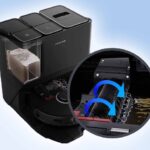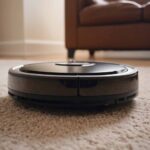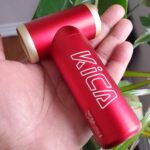The Bissell CrossWave is one of the best multi-surface cleaning tools on the market, making it a fan favorite among people obsessed with cleanliness. But if the CrossWave isn’t cleaned regularly, it becomes a nightmare for those same people.
Here’s how to clean and maintain the Bissell CrossWave in 7 easy steps:
- Unplug the Bissell CrossWave
- Open the brush-roll window
- Remove the brush-roll
- Rinse the roll and window
- Wipe the brush-roll chamber clean
- Dry the brush roll and window
- Replace the brush and window
In this article, you will learn everything you need to know about maintaining a Bissell CrossWave. This includes post-use cleaning and deep cleaning, as well as subjects like odor prevention.
Drawing from sources like Bissell’s own tutorials and general educational resources, this is your definitive guide to cleaning a Bissell CrossWave.
How to Clean Bissell Crosswave Right After Use [7 Simple Steps]
After using Bissell CrossWave, you need to turn it off, remove the units that need to be cleaned, rinse them and scrub where necessary, and towel dry the individual parts.
Let’s explore the 7-step breakdown that simplifies cleaning your Bissell CrossWave after each use:
1. Unplug the Machine From Its Power Source
Simply turning off your Crosswave will not suffice as you need to ensure there is no electricity in the system. This is important because you’ll use water to clean individual components and will remove units that move with electric power.
2. Open the Brush-Roll Window
This step entails grabbing the front portion of the window and tilting it forward. Once the brush roll window is open, you can remove the brush roll, which is the component that needs the most thorough cleaning, most urgently.
3. Remove the Brush-Roll
This step is the one most Bissell CrossWave users make their first cleaning mistake. It might seem more convenient to spray the CrossWave brush with water while it is attached to the machine. However, that keeps a majority of the dirt and residue in the brush. You have to pull up the brush roll tab to remove it.
4. Rinse the Roll and Window
Knowing whether to use detergents when cleaning any vacuuming accessory is important. With Bissell CrossWave, you must minimize chemical detergent exposure. As per the CrossWave manufacturer’s guidelines, warm water is good enough.
The brush roll and the brush roll window both need to be rinsed. As long as you rinse them individually and make sure no residue is left behind, it doesn’t matter which one you rinse first.
5. Wipe Clean the Brush Roll Chamber
The brush roll window and the roll itself get dirty with each use. On the other hand, the brush roll chamber gets dirty only when you use the Bissell CrossWave on a filthy surface.
If you spot visible specks on the brush roll window, you can use a paper towel and wipe with pressure to clean up the surface. This is a situation-dependent step and isn’t mandatory.
6. Let the Brush-Roll and Window Dry
This is the second mistake most CrossWave users make. If you don’t let the brush roll and the roll window dry before assembling them, water droplets will not dry in covered areas like the tab joints. You can towel dry the roll and the window or let it air dry method.
7. Put the Brush and the Window Back in Place
This step concludes the post-use cleaning process of the Bissell CrossWave. Once the brush roll is dry, you’ll need to place it back by putting the right tab end into the right receptor in the brush chamber. Then you’ll need to push the rest of the brush in place.
To put the window in place, you’ll need to line its bottom with the underside of the brush chamber. Once the two are aligned, you can push the rest of the window in place. You’ll hear a click when the top of the window falls into place, and your Bissell CrossWave is ready to use again.
Do I Have to Clean My Bissell Cross Wave After Every Use?
We recommend cleaning your Bissell CrossWave after every use, but it doesn’t need to be deep cleaned every time.
The main units you have to clean every time are the brush roll and the window covering the roll.
Any organic dirt left in the CrossWave brush can lead to contamination and microbial activity. If you’re sure the residue is not organic, you can delay cleaning the CrossWave, but you can’t use it again without cleaning the brush first.
If you try cleaning multiple surfaces multiple times without washing the brush roll, you’ll notice the efficiency of your device drop. The Bissell CrossWave needs to be clear of old residue and dirt to clean new surfaces optimally.
Can You Wash Bissell CrossWave Brush in The Washing Machine?
You shouldn’t wash Bissell CrossWave Brush in the washing machine because the brush or washing machine could be damaged. The brush tab is quite solid, and spinning it in your washing machine is not the best idea.
If the brush is too dirty to rinse in the sink, you can soak it in a bucket of warm water. We recommend using a light-impact detergent if you want to use a cleaning agent. But if you can clean the brush without detergents, you can only use water.
Can You Wash Bissell CrossWave Brush in The Dishwasher?
You can wash the Bissell CrossWave brush in a dishwasher, but the choice is very unhygienic and can damage the brush roll.
For a brush to be cleaned in the dishwasher safely, it has to stay in place, and the water needs to be lukewarm (98-110 degrees Fahrenheit) instead of the normal dishwashing temperature (130-140 degrees Fahrenheit).
Piping hot water or a high-pressure stream can damage the brush roll tab, which is why a bucket full of warm water is a better alternative for cleaning a Bissell CrossWave brush.
The advantage of cleaning with a dishwasher is that it is convenient, and you don’t have to deal with the leftover water. But its drawback is that it can leave your dishwasher unclean, and the brush roll can get damaged.
The benefits of using a bucket are safety, and you can control the temperature and the cleaning cycle duration. But it is more work-intensive.
Overall, the bucket is better as it gives you more control over the cleaning process, and you do get used to draining the rest of the water and can even find ways to reuse it.
How to Deep Clean Bissell CrossWave Brush [7 Easy Steps]
Cleaning a Bissell CrossWave brush requires just rinsing. So what do you do when the brush is full of stubborn stain or grime that doesn’t come off easily?
You deep clean the brush.
Here are the steps to deep clean the Bissell CrossWave Brush:
1. Remove the Brush
The first step requires you to remove the brush. As with shallow cleaning, the process of removing the brush roll is the same. You must open the brush roll window, then detach the brush by lifting it off its chamber.
But before you do that, make sure the machine is unplugged!
You can wear latex gloves if the brush is too dirty. Whatever you do, avoid wiping, rinsing, or applying any solution to the brush while it is in the brush chamber.
2. Rinse the Brush in Warm Water
Again, the initial steps remain similar to post-use brush cleaning. This is crucial because the thinner the layer of dirt on your brush, the better a detergent can clean it.
Don’t waste deep cleaning methods on the initial layer of easy dirt. It takes 15 minutes of rinsing with running water before the easy dirt is entirely off the brush.
3. Add Cleaning Solution to a Bucket
The best cleaning solution for a Bissell CrossWave is an organic one. Organic detergents aren’t corrosive and can quickly mobilize tough stains.
Sometimes, you need to scrub a layer of grime, but that’s for another step. Initially, you need to add one part cleaning solution and seven parts hot water in enough quantity to submerge the brush entirely.
4. Dilute the Cleaning Solution and Drench the Brush
Once you’ve added the cleaning solution, add seven parts water. If the water is too shallow to drown the brush roll, you need to add more cleaning solution followed by seven equivalent parts of water. Once there is enough water in the bucket, you can drown the brush inside.
5. Let the Brush Sit for 30 Minutes
Now that the brush is in the detergent solution, let it rest long enough for the tough dirt and stains to loosen up.
After that, you’ll take it out and check to see if the dirt is manageably loose. If it is not, then you should add one part more detergent without adding more water and repeat the soaking process for another 30 minutes.
6. Scrub off the Dirt With a Sponge or a Rag
With the brush roll soaked in water for a long enough period, it is ready to be scrubbed clean and dried.
Half the time, the brush comes out clean, and the rag’s only job is to dry it. If there is any noticeable dirt on the brush, you should use a sponge or rag to wipe it off. At this point, the dirt should be loose enough to be scrubbed away easily.
7. Let the Brush Air Dry
The rag or sponge will soak up excess water. With the excess water out of the brush, all that’s left is for the brush roll to be air dried.
Keeping it in indirect sunlight or semi-shade speeds up the process. When the brush is completely dry, it can be placed back in the brush chamber.
How to Prevent and Eliminate Mildew Smell on Bissell CrossWave
To prevent a mildew smell on Bissell CrossWave, you need to clean its brush roll after each use and dry it out in the sun. Elimination of mildew smell requires a different course of action.
Here are the steps you should take to eliminate mildew (or other) odor from your CrossWave brush:
- Remove the brush – This can be done by lifting the brush cover after unplugging the machine.
- Spray it with anti-mildew cleaning spray – RMR-86 Instant Mold and Mildew Stain Remover comes in a convenient spray bottle you can use at this stage.
- Remove the water tray – This step is fairly straightforward. You just need to take out the water tray.
- Clean the water tray with detergent – If the water tray is dirty, you should clean it with a detergent and then spray it with the mildew remover.
- Put everything back – This is the final step where you put all the components back in place. After you start using it again, the odor of mildew will be gone.
How to Deal with Smelly Bissell CrossWave Filter
You need to remove the Bissell CrossWave filter and wash it in hot water.
If the smell persists, you should scrub it with a rough sponge and use detergent to clean the filter. After that, you should start cleaning the machine after each use.
How to Clean Bissell CrossWave in Tray
To clean the tray, you must unplug the machine and remove the tray. After that, you should empty the tray and rinse it with hot water.
If the tray is dirty, you should use a detergent and sponge to deep clean it. Then let it air dry after hand rinsing.
How to Clean Bissell CrossWave Hose
To clean a Bissell CrossWave hose, you should run a diluted solution of hot water through it. The solution should feature one part detergent and seven parts water.
Run water through the hose until clear water starts coming out of one end. Then let the hose air dry.
Alternative Floor Cleaning Solutions (Hands-Free)
Although the Bissell kicks butt as a floor cleaning solution, I’ve since upgraded to more of a hands-off floor cleaning solution.
Robot vacuums are quickly becoming one of the best hands-off cleaning solutions. I’ve owned several over the years, and I can never go back to something I have to push manually to clean my floors.
Some might call it being lazy, but I call it valuing my time and reallocating my time-savings (the time I would have spent cleaning the floors) to something else. To me, Bissell has always been a trusted source when it comes to cleaning. But did you know Bissell also makes a 2-in-1 Robot mop and vacuum?
There is still a bit of manual intervention when using the above Bissell bot vac.
In my opinion, the holy grail of hands-off floor cleaning is the Roborock S7 MaxV ultra. Don’t let the price shock you, this robot vac is pretty much Rosie from the Jetsons. If you don’t get the reference- Rosie is a cleaning-obsessed robot maid character in a futuristic cartoon.
A few lifesaving features
- Self-cleaning mop pad
- Self-emptying dirt bin
- Scheduled cleaning
- Zone/spot cleaning (I use this feature every day after I feed my son, love it)
- Remote cleaning (for the days when you’re not home and you have that unexpected guest drop by)
- Avoids objects (This thing is amazing at avoiding kid’s toys and animal waste on the floor)
- Tangle-free vacuum brush roller
FAQ
Bissell CrossWave has a self-clean option that flushes dirt and debris from the machine’s system. However, you need to handwash the brush.
Bissell CrossWave will not clean grout because its brush bristles aren’t small enough to reach the tile crevasses. Still, if you use hot water in the rinse tank and pre-spray the tiles with a neutral detergent, some grout will come off with a CrossWave.
As a general rule changing your Bissell CrossWave filter every three or four months is recommended. However, the frequency of your use will ultimately determine if you need to change it sooner or later.
Recap: How to Maintain and Clean the Bissell CrossWave
Here’s how to clean and maintain the Bissell CrossWave: To clean a Bissell CrossWave, you need to detach the filter, brush, and tray, then individually hand-rinse them. Once rinsed, they should be air dried and put back into the CrossWave. Your CrossWave brush needs to be cleaned after each use and deep cleaned once a month.








